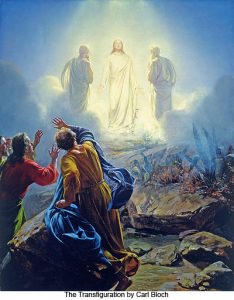HOMILY LENT SUNDAY 02 – B
Lent – A Journey of Transformation
(Genesis 22:1-2, 9-13, 15-18; Psalm 116; Romans 8:31b-35, 37; Mark 9:2-10)
****************************************************************
“To live is to change; to have lived well is to have changed much.” This quote from Cardinal Newman brings us to the core of today’s celebration.
Lent is a journey of transformation through the Cross.
The journey theme wends its way through readings for the Sundays of Lent. Last Sunday, we journeyed into the desert with Jesus to face the temptations. This Sunday, we journey up a mountain to witness his transfiguration. The first reading today from Genesis recounts Abraham’s journey into the land of Moriah where his faith was tested by God and found to be true and steadfast. And always in the background is the disciples’ on-going journey of faith in Jesus, learning who he is and who they are in the light of that knowledge.
The whole season of Lent is meant to be a journey of transformation for us, the present-day disciples of Jesus. The word that is used for transfiguration is metamorphothe, meaning metamorphosis, or transformation. The account of the transfiguration of Jesus has one goal – to prepare the disciples for the journey of Jesus to the Cross, for the way that Jesus would reveal the depth of God’s love for us by overcoming the power of death and evil in the world, that we call the Paschal Mystery.

Transfiguration – Carl Bloch
Moses and Elijah appeared to Jesus and they were discussing with him “his passing in Jerusalem”, his passion, death on the cross and his resurrection. Though Mark does not specify this, the other gospels do. This reality builds on the identity of Jesus, which is addressed throughout the first half of Mark’s gospel. Chapter 8 is a turning point where Jesus asks the disciples “Who do you say that I am?” and Peter responds, “You are the Christ, the Son of the Living God.”
This gospel passage about the transfiguration seals that declaration of faith. Jesus is greater than Moses (the great Lawgiver) and Elijah (the great Prophet). God’s voice breaking in from the heavens, Moses and Elijah, all testify to who Jesus is – the Messiah and Son of God. Jesus is different than Moses and Elijah – he would come into his glory through suffering and death. The pattern of his death and resurrection is the pattern that we are asked to take up as we follow Jesus through the Cross to glory.
The New Interpreter’s Bible offers us some insights into this mystery. Christians frequently think of the divinity of Jesus in terms of heavenly glory or the triumph of the parousia without recognizing the real presence of God on the cross. We tend to think that Jesus is most clearly Son of God in glory, not in suffering. This passage challenges us to revise our understanding of how God’s presence comes to the world.
The command to silence reminds Christians that glory and suffering cannot be separated. Appearances of glory alone do not provide evidence of God’s truth. Sometimes people expect historians to describe Jesus as such an overpowering personality that people will be compelled to believe. Or they are scandalized by books that treat Jesus as someone who the educated elite of his time would hardly have noticed. Mark warns that faith grasps hold of a different reality. Dramatic miracles and heavenly visions do not create faith. Christians know that the crucified Jesus is now risen and is exalted with God. Jesus Christ is present to believers without signs and wonders, but through faith, hope and love.
What is our response to be? Our response as disciples must be a response of obedient faith and genuine love. The first reading shows us the total, obedient faith of Abraham. The second reading reminds us of the total, obedient faith of St. Paul in Jesus as Son of God, and as the love of God made present in our world. Can we put our faith in Jesus as Suffering Servant, not only Son of God and Messiah?
Jordan, the grandson of Ed and Angie Mihalicz in Beauval, was always interested in science. He had a pet Tarantula spider. One day he called his grandfather to look at his pet, as it seemed to be sick. The next time they checked on it, they were surprised to see what seemed at first to be two of them. Upon closer inspection, they realized that what seemed to be a sickly version of the healthy spider was really the skin or shell that it had cast off. The spider had molted and literally stepped out of its old shell into a new one. The spider had been transformed.
That is what the Christian, the disciple of Jesus, is called to by faith. We are to let God transform us into new creatures, renewed followers of Jesus who are living his new way of life, a life of impossible love and forgiveness, casting off any sin, darkness, or defects of character that do not belong in the reign of God.
The Eucharist is a celebration that is an act of faith, like that of Abraham. It is also food for our journey into transformation. We are being transformed into the Body of Christ, the beginnings of the kingdom of God here on earth
So, let us truly enter into the spirit of Lent and make it a journey of transformation through the Cross of Jesus Christ.



